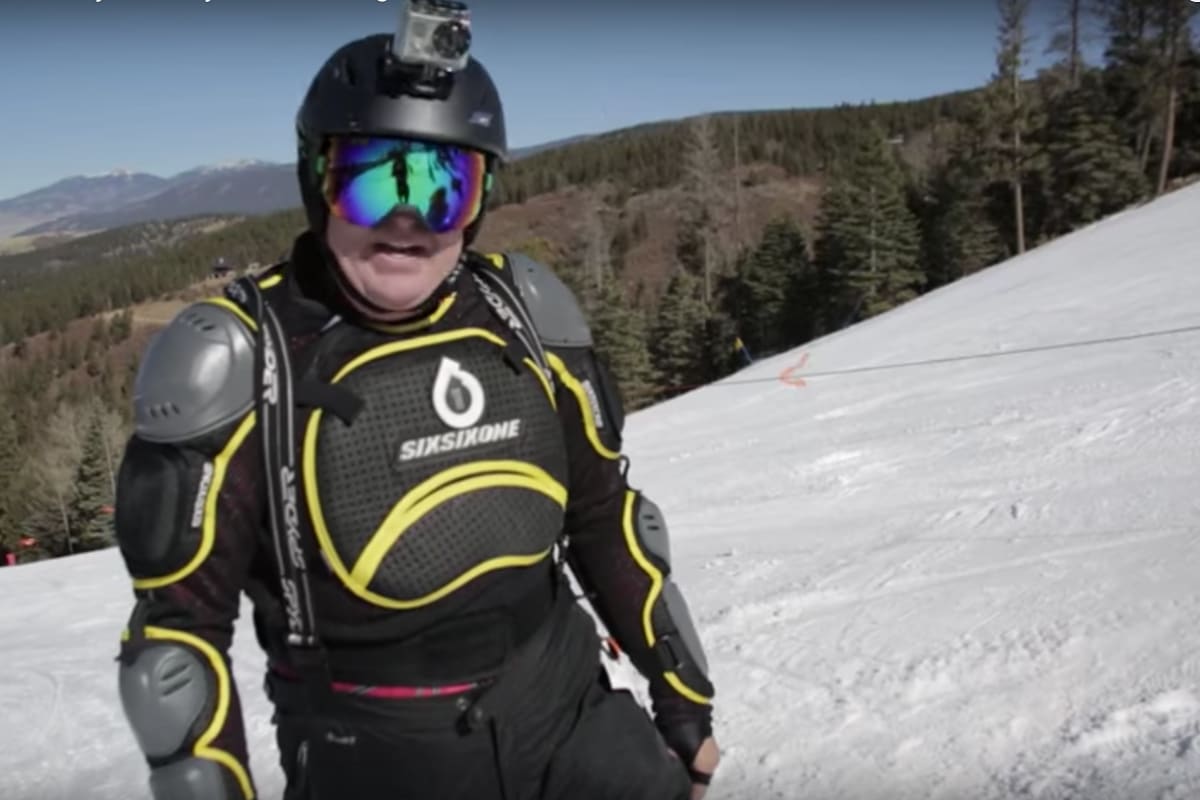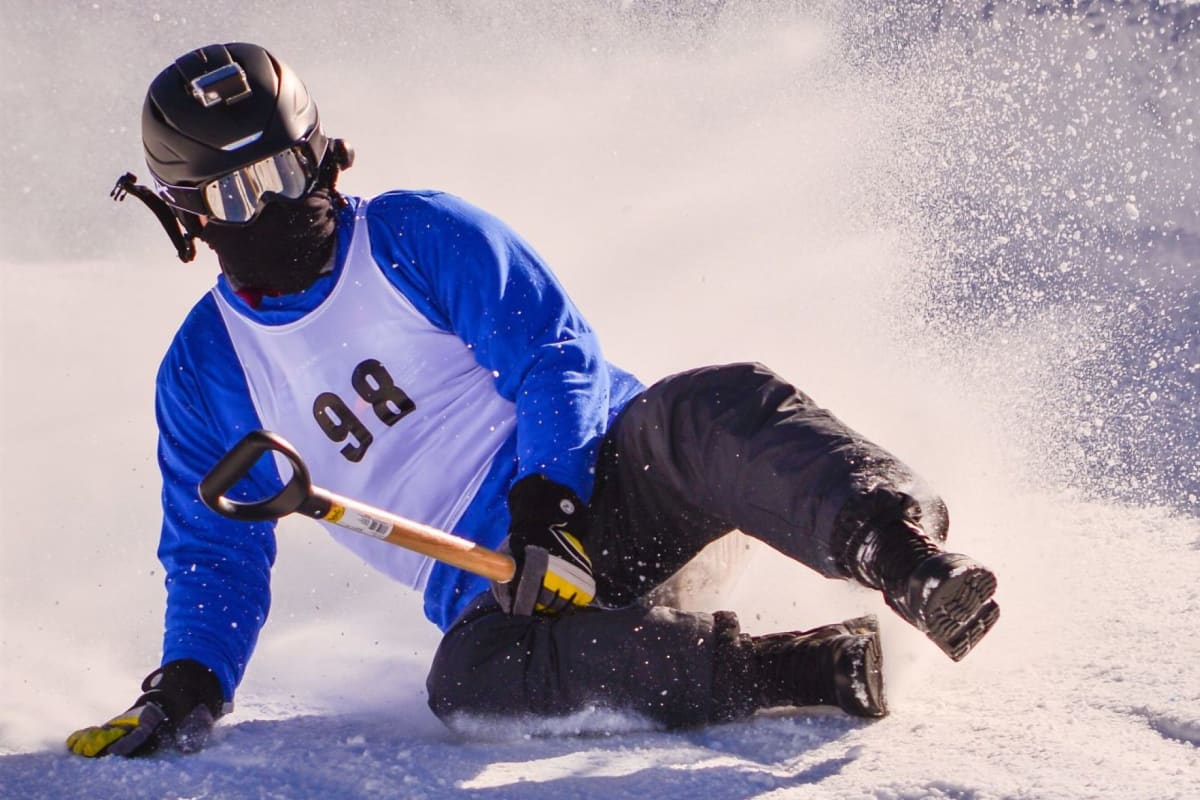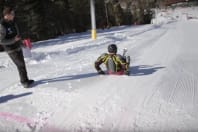In the week running up to The Shovel Racing World Championships, we caught up with John ‘Shovelmeister’ Strader in a camera shop in Albuquerque buying supplies for the big day. He takes us through the technicalities of the sport that’s not only capable of smashing through fences but can also rip through social barriers as well.

The most famous, revered and decorated Shovel Racer of all time...
Chillisauce: So john, how did you become involved in shovel racing?
The Shovelmeister: Y’know I grew up skiing my whole life so it was just something to do that was a little different. Then in 1988 I took second place and that’s what gave me the bug and I’ve been back every single year and I’ve been racing for thirty something years now.
CS: How dangerous is it John?
TS: Well, y’know it’s actually not that dangerous. It looks more dangerous than it is because unlike skiing or snowboarding you’re on the ground so you don’t have anywhere to fall. Y’know you just fall off the shovel and you slide. Where it’s dangerous is that it’s a ‘fall line sport – you can’t control it, you can’t turn. So if you’re not on a hill made for shovel racing the danger is that you’ll fly off the hill into a tree or a rock.
CS: How scary is the racing?
TS: The biggest concern at the races is the snow wall. They make this big snow wall on either side of the track and if you hit that thing at 70mph it’s going to hurt. So it really depends on where and how you’re doing it.
CS: So if you’re going down the hill towards something you really don’t want to hit, what’s the tactic?
TS: Yep, you’d better hit the brakes or get off because you can’t swerve, you can’t turn so you’re only option at that point is to bail. But when you’re going that speed and you jump off the shovel you’re still sliding so that’s why you can’t just take a shovel up to a ski hill if there’s a bunch of obstacles because there’s no way to dodge.
CS: Apart from the money aspect and it being so much cheaper, what is it that you love about shovel racing as opposed to skiing etc?
TS: The thing is the adrenaline you feel when you’re riding a shovel down that course is unlike any feeling I’ve ever had on skis or doing any other sport because it’s just pure speed. You’re sitting on your butt kind a in a luge position and you’re doing 70mph, it feels like you’re doing 170. I mean there’s nothing like it.
CS: You’re probably the most famous shovel racer in the world, so what does that mean to you?
TS: Y’know what it means to me is trying to be an ambassador for the sport. Let people know that it’s not as crazy as it sounds, it’s a lot more fun than it looks, it’s not as scary as it looks, anyone can do it and it’s the kind of sport that deserves to spread, it deserves to be done at many more places than just Angel Fire.
CS: How important is being number one to you John?
TS: To be able to say you’re the best at something and a world champion at something, even something as obscure as shovel y’know it always feels good. I’m never gonna be able to ride a shovel in the Olympics – I’m aware of that but maybe someday maybe my kid will or my grand kids will or somebody will and they’ll say this was the dream of that guy Strader who was the one guy who always believed in this sport even when it was y’know near failure for years.
"You’re shit out of luck kid, too bad you crashed" - The Shovelmeister
CS: What should the hill look like if we wanted to go Shovel Racing?
TS: You have to have to have a pretty smooth hill with no debris, or trees or stuff like that so that way you can have a nice long run out at the end. So with that it’s like balls out straight down the mountain and have enough room to stop at the end. Y’know it takes me a hundred yards to stop.
CS: So how do you slow down?
TS: Well, you sit up, put your feet down but at that speed when you put your feet down you get like a face full of snow instantly. So you put your feet down, you can’t see because your goggles are packed with snow and y’know you just start slowing down. You pull the shovel out. Some people think you pull the shovel up like it’s a brake but then what happens is you bend your shovel and then it’s worthless so you don’t wanna do that. So we just bail off the shovel and slow yourself down to a stop.
CS: If you’re going down the hill towards something you really don’t want to hit, what’s the tactic?
TS: Yep, you’d better hit the brakes or get off because you can’t swerve, you can’t turn so you’re only option at that point is to bail. But when you’re going that speed and you jump off the shovel you’re still sliding so that’s why you can’t just take a shovel up to a ski hill if there’s a bunch of obstacles because there’s no way to dodge.
CS: And you’re happy for it to be more of a pure sport, just you and the shovel?
TS: Y’know I’m just happy that we’re free to ride our shovels. I’ve always been a purist I love riding the regular shovel a lot more than the bigger sleds because y’know I used to say it was cheap and steep – when you go snowboarding or whatever, you gotta go spend hundreds of dollars on your boots and all of your gear. Y’know a shovel is like thirty bucks, buy your lift ticket and you’re doing it. Y’know it’s a real blue collar anyone can do it.

Sixteen years ago, as Shovel Racing stood primed to become the next big global winter craze, it suffered the most catastrophic day in its short history. At the 1997 Winter X Games, the modified Shovel Racers endured a day of complete carnage on a course they should never run. The Shovelmeister, like most, crashed horrifically that day, as he tells us.
CS: So tell us about ‘that’ big smash
TS: Basically in 97 it was the very first Winter X Games. So they called us up in the Fall and they said ‘look we need 4 sleds’. So I got together some sponsorship, put together some other teams and we built three more sleds. We put them together real quick and we didn’t really have time to test them.
They changed the format so the people who made it to the finals made about 16 runs which is literally 8 years of shovel racing in 2 days. So the sleds were not designed to do that many runs.
Most of the sleds crashed, it was a war of attrition. So now we get to the course – they didn’t have the right type of course. It had a fall line issue as it was dragging everybody towards the wall on the right. So you had to fight it the whole time just to stay straight.
I was up there trying to talk to the head of the X Games and I was like ‘look we can’t go down this course we’re gonna get killed’ and he just looked at me like I was crazy and I’ll never forget he said ‘Mr Strader this is live television, you either go, or go home’.
And I was like ‘if I Go I might just go back in a body bag, I just need you to know that. I mean this course is very, very dangerous’. And then, over the course of the entire event, everybody crashed including myself. My ski just went in the rut and my sled followed it and all of the sudden I’m flipping end over.
CS: It says a lot about you commitment to shovel racing because I understand that it not only had a physical impact on your body but financially it hurt you too didn’t it?
TS: Very big, yes. There was a rumour flying around that I actually sued the X Games and won millions of dollars and that’s why they didn’t carry us. Well, that’s total bullshit. I mean, I never got a dollar from them and I ended racking up about $35,000 in medical bills which I couldn’t pay. I had to declare bankruptcy to do something about these medical bills, because they didn’t do anything, it was like ‘you’re shit out of luck kid, too bad you crashed’ and that was it.

Shovel Racing: The story of the cult winter sport
It’s usually the most interesting things in life which almost happen by accident. Take that caveman sitting around waiting for fire to be invented; there he is picking bits of woolly Mammoth from in between his teeth with a bit of flint when he spies a round ball of stone. Unable to control his urges he hoofs it into action, ’nutmegs’ a Pterodactyl and punts it into a cave. The very first goal in the history of the world has just been scored and life will never be the same again, although the players will remain remarkably unchanged. But you get my point.
And so it is with Shovel Racing. You almost certainly haven’t heard of Shovel Racing but there have been points over the last three decades where it has threatened to explode and achieve the primary status which its dedicated followers firmly believe it deserves. And it’s those diehard fans who are convinced that we’re about to witness another golden age of the sport.
Thirty years ago in the New Mexico Ski Resort of Angel Fire, a team of lift attendants, who were going about their normal business of repairing divots on the piste, suddenly realised that the easiest way to get from divot to divot was to sit on the shovel and sledge. A standout moment in the history of winter sport had just been created, and before long people were packing the slopes to race on their shovels. Things quickly developed with the sport splitting into two distinct categories: the ‘modifieds’ and the ‘shovels’. The former are buggies built on to shovels that can look like a cross between a bobsled and a spaceship, with the latter being the purest, less dangerous discipline.
The sport maintained a healthy but cult following in the Angel Fire resort with local teams tinkering away with their ‘modifieds’ to squeeze out greater performance and purist shovel racers honing their technique to become the fastest person on a shovel. However, almost from the beginning it was never simply a way of spending time. Sliding down a frozen hill with absolutely zero control at speeds of up to 70mph is of course as much of a thrill for the spectators as it is for those who take part. The ever increasing demand for speed brought huge demands of the ‘modifieds’ and their crews and of course with that came increased danger. Being asked to travel anywhere at 70mph, with no firm way of steering, stopping or indeed controlling your speed in any way asks for a special breed of man. One that won’t stop whatever the conditions, whatever the risk, that just can’t say no to taking the shovel down the hill for one more run. And unfortunately it’s just that sort of spirit that led to one of the key low points in its history.
Television and mainstream media had enjoyed dalliances with shovel racing since its early days but its first big moment, and nearly its last, was at the 1997 Winter X Games. On the very last day of the games the Modifieds competed on primetime tv, on a slope which mountain bikers had spent the morning carving up. Despite racers’ protestations the ensuing carnage was wholesale, as uncontrollable machines, unable to do anything but follow the churned up tracks, were sent careering in all directions. Nearly all the machines crashed but one was a little more spectacular than others and gave birth to not only a shovel racing legend but also the most defining moment of its history. John ‘Shovelmeister’ Strader flipped his craft at over 70mph and suffered a bruised heart, a cracked sternum, a broken jaw, a broken leg and a broken back in 3 places. The hospital bills forced him into bankruptcy.
Following the accident Shovel Racing was taken off the X Games roster and disappeared for a while as people tried to come to terms with what it had become and tried to figure out where it was going. Then, slowly, like a mighty phoenix from the flames, locals started getting back on their shovels and taking to the slopes. After a four year hiatus, and with his life back on track, The Shovelmeister rekindled his love affair with the sport which had made him a cult figure. Three years ago Angel Fire Resort restarted the Shovel Racing World Championships for back to basics shovel purists and the Shovelmeister is once again the man to beat.
So at this weekend’s Shovel Racing World Championships at Angel Fire Resort, New Mexico, on Saturday 12th February he will be once more hoping that this is the year, this is the race, which takes it global. Are we about to witness new dawn of one of the most leftfield, crazy and highly addictive winter sports known to man? Maybe, maybe not but one thing is sure: the world needs more things like shovel racing and it needs more men like the Shovelmeister.












